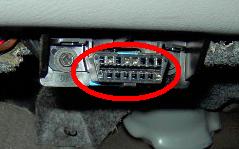In order to scan your car for codes, you must first locate the diagnostic connector. It will be under the drivers side dash. Here is an example of its location. Your vehicle may be in a little different spot. If you do not have a code reader tool, many of the large national parts store chains will scan your cars computer for free.
On today's newer vehicles (1996-and up, OBDII), the diagnostic terminal is what powers up the scan tool. If the scan tool does not power up after plugging in to the connector, you will need to check fuses. Different vehicles use different fuses to power this connector. After reading the codes(s) and the short description, you will need to use a diagnostic chart to pinpoint the problem. Just because the scanner shows, lets say, a code for the intake air temperature sensor, does not mean that the sensor is bad. The most basic scanners will just read trouble codes from the Powertrain Control Module (PCM). A little higher priced scanners will read codes, and give some live data streams. The high end scanners will do this, and read other computers such as Body Control Module(BCM), Anti-lock Brake module(ABS), Airbag module(SIR), Door modules, 4-wheel drive modules, etc. These will also be able to control devices in a given circuit to go along with diagnostic charts, and run per-programmed test, and re-program replacement computers.


More Auto Repair Help


